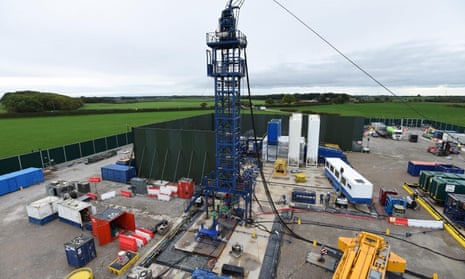The government’s plan to establish fracking across the UK is years behind schedule and has cost the taxpayer at least £32m so far, Whitehall’s spending watchdog has found.
An investigation by the National Audit Office (NAO) said the shale gas industry has launched only three wells in three years, even though the plan was to establish 20 by the middle of next year.
Taxpayers have spent at least £32m in total on the industry, a report released on Wednesday reveals, £13m of which has been spent by police forces maintaining security in the face of protests.
Auditors also expressed concern that official regulators such as the Health and Safety Executive, the Environment Agency and the Oil and Gas Authority rely upon the statutory self-reporting of problems by the industry.
Landowners may ultimately be liable for the decommissioning costs of fracking sites, the report said, should an operator be unable to cover them, but arrangements are “unclear and untested”.
The findings have been pointed to by Labour as further evidence that fracking has been a waste of public money and should be halted.
Rebecca Long-Bailey, the shadow business and energy secretary, said: “Fracking threatens air and water quality, and it contributes to the climate crisis. And as this report reveals, the government’s plan for making fracking sites safe after they’ve been used is unclear and untested. Well let me be crystal clear, Labour will ban fracking immediately.”
Fracking, or hydraulic fracturing, is a technique in which high-pressure water, sand and chemicals are pumped into shale rock to help extract natural gas. It is estimated that more than 2.5m wells have been hydraulically fractured worldwide.
Q&AWhat is fracking?
Show
Fracking, or hydraulic fracturing, is a way of extracting natural gas from shale rock formations that are often deep underground. It involves pumping water, chemicals and usually sand underground at high pressure to fracture shale – hence the name – and release the gas trapped within to be collected back at the surface.
The technology has transformed the US energy landscape in the last decade, owing to the combination of high-volume fracking – 1.5m gallons of water per well, on average – and the relatively modern ability to drill horizontally into shale after a vertical well has been drilled.
In England, the government placed a moratorium on fracking in November 2019 after protests, legal challenges and planning rejections. A year earlier, the energy company Cuadrilla was forced to stop work at its Preston New Road site in Lancashire twice in four days due to minor earthquakes occurring while it was fracking. The tremors breached a seismic threshold imposed after fracking caused minor earthquakes at a nearby Cuadrilla site in 2011. In March 2019 the high court ruled that the government's fracking guidelines were unlawful because they had failed to sufficiently consider scientific evidence against fracking.
In 2016, the Cabinet Office said it expected that up to 20 wells would have been fracked in the UK by mid-2020, but only three have been so far.
Site operators have said the system to protect against the risk of earthquakes is stricter than that used internationally and claim this has hindered their ability to develop the industry, the report said.
Auditors found that operations have proved costly for local authorities and police forces, which manage anti-fracking protests, traffic disruption and general public safety at the sites.
The report estimated that at least £32.7m had been spent by public bodies since 2011, although the exact full costs are not known.
Public concern about fracking operations centres around greenhouse gas emissions, groundwater pollution and fracking-induced earthquakes. In August, a tremor measuring 2.9 on the Richter scale was detected at a Cuadrilla fracking site near Blackpool, the largest ever recorded at the site. Fracking has been indefinitely suspended since, but has not been abandoned.
Jamie Peters of Friends of the Earth said: “This is a quietly critical report that doesn’t give the fracking industry any revived sense of hope. The NAO has several concerns including the mark-your-own-homework approach to regulation and the lack of clarity over who should be responsible for clean-up costs if fracking ever got going.”
The Department for Business, Energy and Industrial Strategy (BEIS) told auditors that climate change objectives could be met while developing shale gas, but that the necessary technology had not yet been developed.
Ken Cronin, chief executive of UK Onshore Oil and Gas, the industry trade body, said the report highlighted delays in the planning system which have contributed to slower than expected progress.
He said: “The report comments on the need for hydrogen and carbon capture and storage, recommended by the Committee on Climate Change as essential in meeting the net zero target.
“There is a significant role for both onshore oil and gas in the future, which if allowed to reach potential will bring the compelling environmental and economic benefits as detailed in the National Audit Office report.”
A spokesman for BEIS said: “The government has always said shale gas exploration can only proceed as long as it is safe and environmentally responsible. The Oil and Gas Authority will soon publish a finalised scientific assessment of recent industry data and we will set out our future approach as soon as we have considered the findings.”
